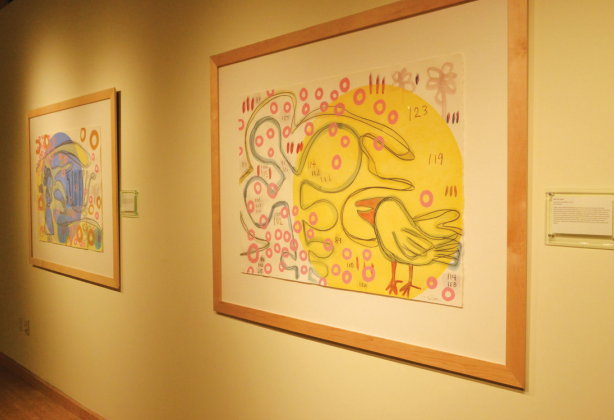Art Gallery Collaborates with Health Sciences for Exhibition
The Pauly Friedman Art Gallery is hosting an exhibition in collaboration with the College of Health Sciences.
The Arts in Healthcare exhibition, which will run until Oct. 20, showcases artwork made with the theme of healthcare and will be part of the college’s annual Health Care Symposium on Friday, Oct. 18.
Lalaine Little, director of the art gallery, said the exhibit was put together in one year with the help of artists she knows who work in healthcare.
“This is a part of a growing movement in the arts to combine the idea of wellness and healthcare with the arts, so we’re actually jumping on board with an existing bandwagon,” Little said.
She said the main goal of this exhibit is to make the connection between the arts and health for students planning to enter the healthcare field.
“We’re showing a wider range of what’s available with arts and health. Overall, what we want to do is encourage healthcare administrators to incorporate the arts as part of their healing environment,” Little said.
She said one thing that makes this exhibit unique is the artist featured shows their own interpretations and experiences in healthcare through their pieces.
“They all have their own project, so we have a couple of artists whose work is significant because of the technological applications; it’s just that the end result is aesthetically interesting. Then, we have other artists who choose to thematically link their artwork with some aspect of their healthcare. Then, we also have other artists whose work doesn’t have anything to do with healthcare, but the visual image is something that would be well received in a healthcare environment.”
She also said she thinks people will be drawn to the wide variety of art displayed in the exhibition.
“Sometimes, we have artwork that is the same artist or they all work in the same aesthetic mode, but we have such a variety here. We can see the range of human expression and how people deal with illness. All these artists have a story and message they’re trying to reach with their art and that’s always very interesting,” Little said.
A few pieces of art stuck Little the most. One was “Device 39C (Insulin Pumps)” by Holland Houdek.
The sculpture is made of copper that Houdek shaped by hand and features the use of actual insulin pumps.
Little said some of Houdek’s other works are made in a similar fashion and one piece included implants that the artist described as “half mechanical and half parts of the human body.”
“It’s really asking questions about the alterations we make to our bodies for better life,” she said. “These are always just really visually striking to me because the response is always, ‘What is that?’ which is really nice.”
Another favorite of hers is Alexandra Rutsch-Brock’s “100 Hearts,” a piece she likes because it shows the personal experience the artist had dealing with the field of healthcare.
Melanie Yazzie’s paintings titled “You are in my heart” and “Morning Prayer” also stuck out to Little. She admired the way the artist used Native American symbols that no one would expect to see.
Little loves helping build the bridge between art and other disciplines.
“I think all of our programs should have some aspect that allows students to explore other parts of the human existence,” she said. “So, this is designed particularly for students who are going into the healthcare fields that may not have another opportunity to experience the arts and are really quite busy memorizing things and learning about practical applications within the sciences, but the whole person isn’t as emphasized,” Little said.
She wants students to think about other factors in dealing with a patient.
“We’re trying to encourage people to think about things like cultural influences in a patient. Even though it’s not directly related to their illness, it may affect how they approach illness, how they approach wellness, what their relationship with their doctors is expected to be, what their relationship with death and quality of life is. All of those have such a wide range and we’d really like students to think about that.”
Little would love to collaborate with other colleges and departments in the future.
“If they would bring ideas to me, I’m happy to chase them down for sure,” she said. “Some sort of visual arts aspect that would compliment what they’re doing. I would teach it from my perspective, of course, with an emphasis on the art historical technique or the conditions in which this item was produced or received in its time. But there are so many different ways of seeing that people in other disciplines can really link to.”
Little is always open to taking suggestions from students, as well.
“We’re open to all kinds of ideas of what people would like to see and what artwork we haven’t seen yet. I’m always asking people how they’re reacting to things and what kind of things they want to see. The world of art is so big and I’ve had wonderful artists introduced to me by students. Whatever they say, let me know,” she said.
Little invites people to come into the gallery to hang out and relax.
“I don’t mind if people come in here to just read their email or clear their thoughts,” she said. “It’s a very relaxing environment and you can get lost in a painting if you need to concentrate on something.”

